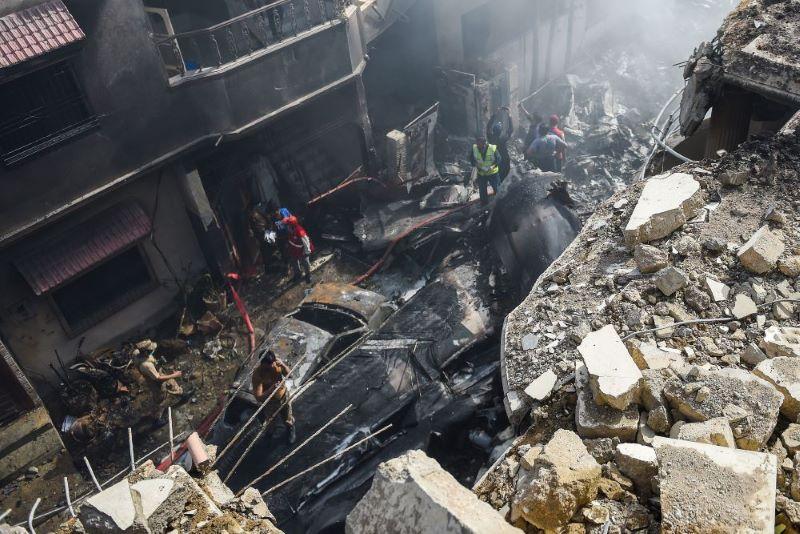
A preliminary report into the May 22 crash of a Pakistan International Airlines (PIA) Airbus A320 raises fundamental questions about crew proficiency and shows erratic behavior during a highly unstable approach into Karachi’s Jinnah International Airport.
All but two of the 99 people on board died, as well as one person on the ground.
The report, published June 24, said the pilots chose to continue their final approach despite it being significantly too high and too fast, while also retracting the already extended landing gear only about 5 nm from the airport. “The crew did not follow standard callouts and did not observe CRM [crew resource management] aspects during most parts of the flight,” Pakistan’s Aircraft Accident Investigation Board (AAIB) wrote in the report.
The aircraft was on a scheduled domestic flight (PK8303) to Karachi from Lahore, leaving at 1:05 p.m. local time with eight crewmembers and 91 passengers on board. While nearing Karachi, the aircraft was cleared for a direct vector to the Makli waypoint, 15 nm from the field. Karachi approach controllers cleared the aircraft to descend to 3,000 ft. overhead of Makli, but it was still at 9,780 ft. and an indicated airspeed (IAS) of 245 kt.
The report does not specify which pilot was flying nor does it include a transcript of internal cockpit or air traffic control (ATC) communications.
Realizing excessive altitude, the crew selected the “OPEN DES” mode on the flight control unit. Both autopilots were disengaged, and the speed brakes extended. ATC then requested the crew to “confirm track mile comfortable for descent” and recommended taking an orbit to lose altitude and for the aircraft to intercept the glideslope safely. The crew chose not to execute an orbit and instead continued the fast descent. At 10.5 nm from the runway threshold and at 7,221 ft., the landing gear was lowered.
ATC advised the crew twice to discontinue the approach and alerted it about the issue another time. At an altitude of 1,740 ft. and having now intercepted the glideslope and localizer, the pilots raised the landing gear again and retracted the speed brakes. The crew selected the Flaps 1 position at a speed of 243 kt., triggering overspeed and enhanced ground proximity system warnings.
In a deviation from normal procedures, Karachi Approach did not hand over the aircraft to “Aerodrome Control” but instead sought landing clearance for it by telephone. Aerodrome Control granted the clearance without noticing that the gear was up.
According to the AAIB report, the A320 was descending through 500 ft. at Slats/Flaps 3, a speed of 220 kt. and a descent rate of 2,000 fpm. with the gear still retracted. Both the flight data recorder (FDR) and cockpit voice recorder document several warnings about overspeed, the landing gear not being down and ground proximity, all of which were ignored. The aircraft touched the runway on its engines and the crew applied reverse thrust and “initiated a braking action,” according to the report. Both engines were damaged, and Aerodrome Control conveyed its observations about the gear-up landing to Karachi Approach, but neither alerted the crew.
Finally, the crew decided to discontinue the landing and go around, although the FDR indicates a brief action to move the gear lever to the down position that was reversed immediately. The crew told ATC it intended to go around for another approach to the same Runway 25L, but shortly after becoming airborne again both engines failed. The ram air turbine was deployed, and the aircraft was unable to retain altitude. It crashed into a residential neighborhood 1.3 km (0.8 mi) from the runway threshold.
The report notes the gear again was in the extended position at the crash site and “did not demonstrate any malfunction.” The free-fall mechanism was not used. Both engines were found to likely not have produced any thrust immediately before impact.
AAIB said it will continue the investigation with a focus, among others, on crew training and qualification and the aircraft maintenance status.
The A320 was registered as AP-BLD and built in 2004. It was powered by CFM-56-5B4/P engines. It had accumulated 47,124 flight hours and 25,866 cycles. China Eastern Airlines operated the aircraft from 2004 until 2014; it was delivered to PIA in October 2014.





